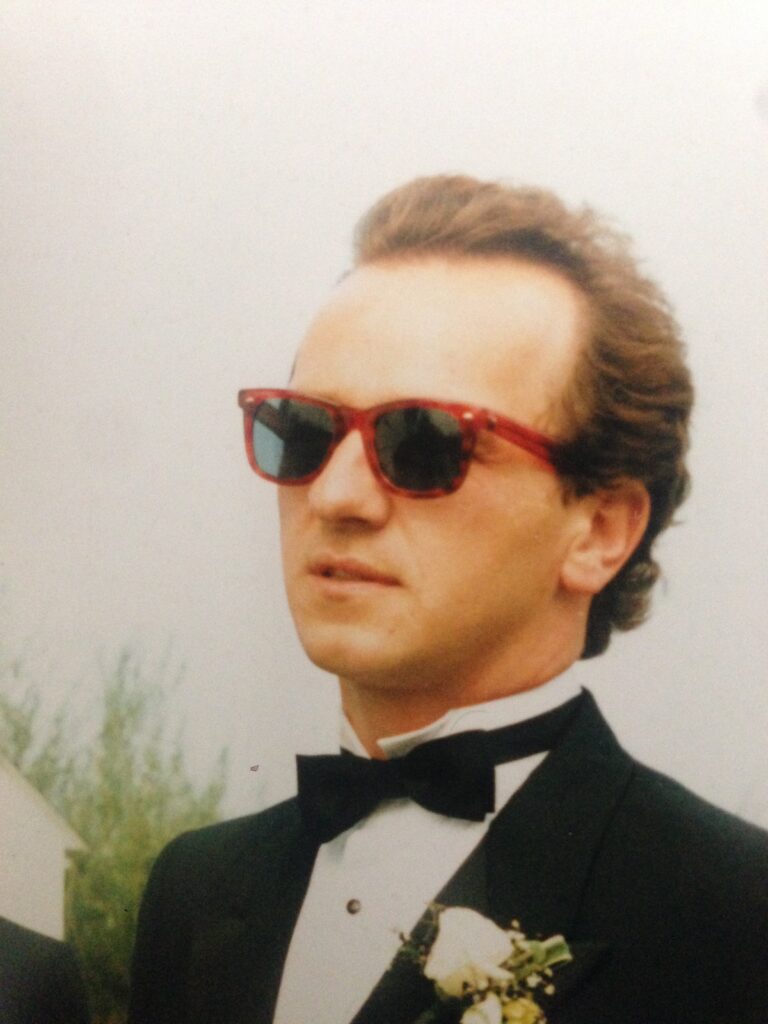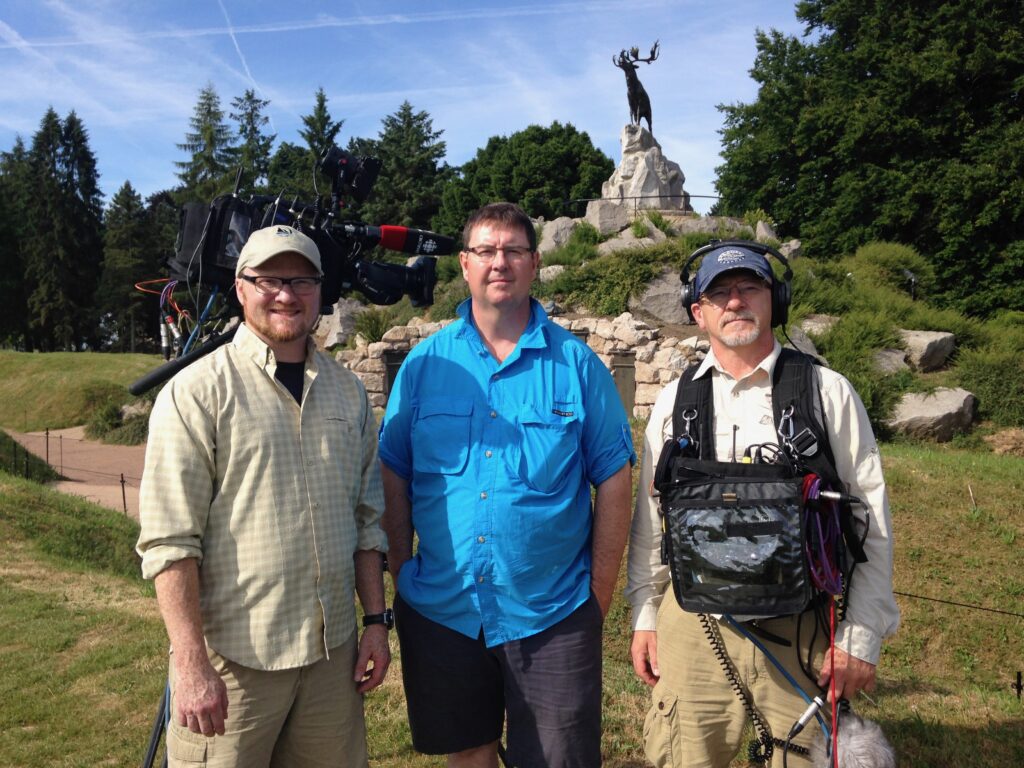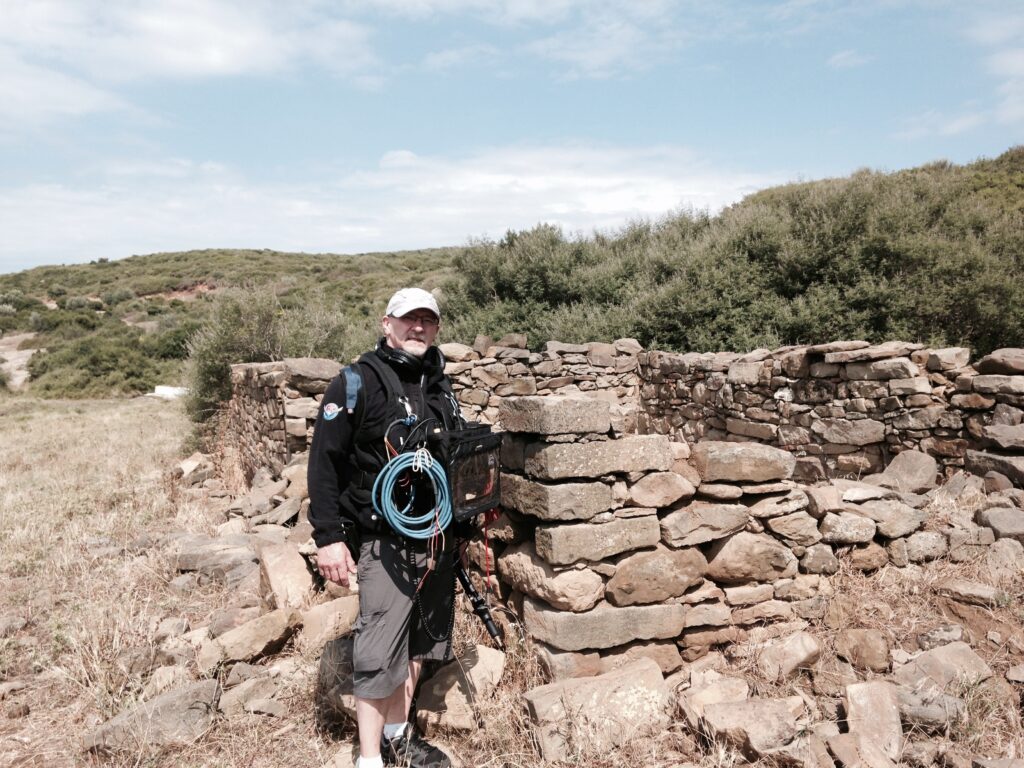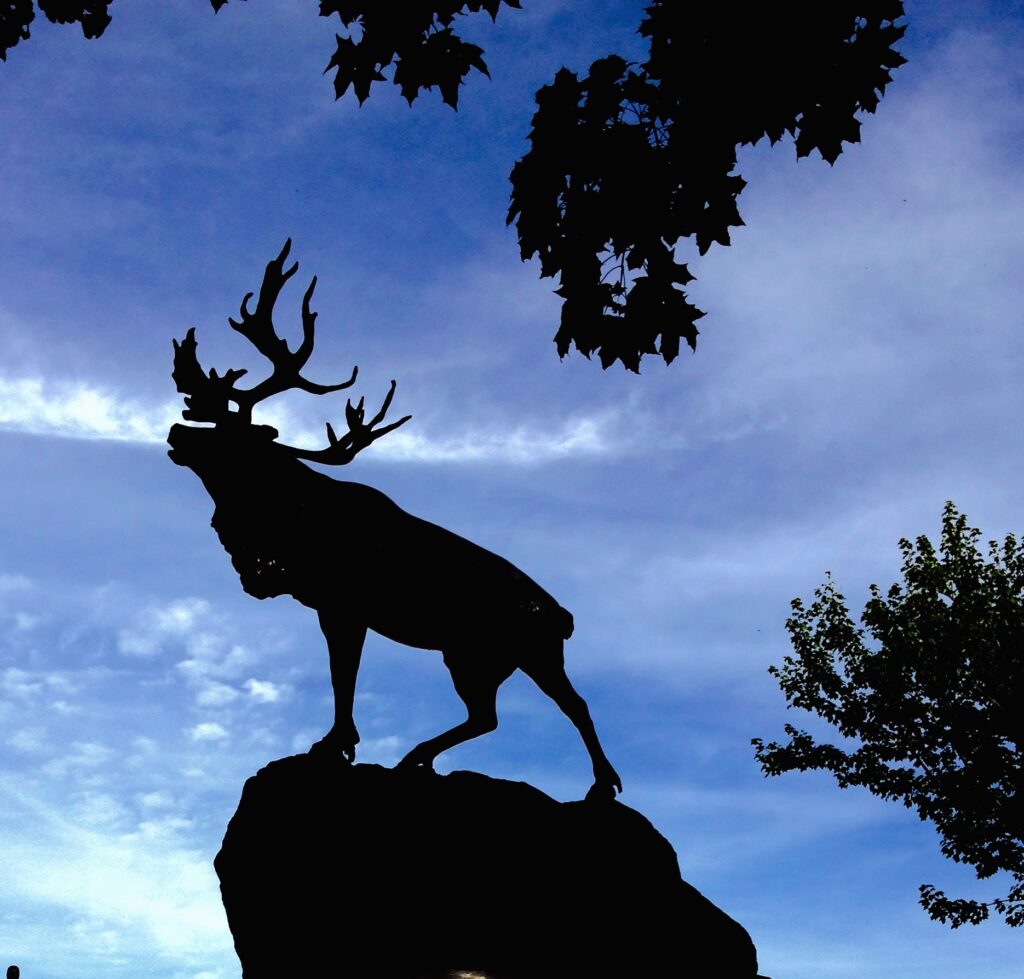In 1984, the Basilica-Cathedral of St. John the Baptist still dominated the cityscape of St. John’s Newfoundland, long before downtown hi-rises took root and the construction of the art gallery and museum known as The Rooms. The great, grey building, designed in Romanesque style, completed in the mid-19th century on the highest point overlooking the city, was what you focused on coming through the Narrows into the harbour. On the main floor inside the Basilica, in September of that year, a young Bob Sharpe was bent over and walking backwards, focused on dragging a large cable, doing his job as a freelance technician for the CBC. Intense in his work, and oblivious to his surroundings, he suddenly felt a firm hand on his back. He straightened, looked around, and saw that the hand belonged to a plainclothes member of the Swiss Guard. Bob understood the reason for the hand: Pope John Paul II stood ten feet away and directly in the path of totally absorbed Bob dragging the immense cable.
Pope John Paul II was on an historical visit to celebrate the 200th anniversary of the establishment of the Catholic Church in Newfoundland and the CBC documented every moment. 1984 was a long time before our current world of compact, wireless devices. Covering a major event in those days required equipment that resembled a travelling movie studio: massive cameras, lights, microphones and heavy cables. With the papal visit, when one event was over everything had to be quickly torn down, loaded into trucks and vans, transported to the next location and re-constructed. On the phone, Bob told me he never worked so hard in his life. He also told me it was one of the two most memorable work experiences. In fact, the two work experiences come close to bookending his career, with the papal visit near the beginning and his participation in the 2016 documentary, Trail of the Caribou, nearer the end.

During this discussion on the phone I mentioned to Bob that I found his papal story somewhat ironic given his attitude to the church. Bob didn’t disagree but simply said there was something captivating about Pope John Paul II. “What is interesting is the aura that projected from him. I had never experienced that feeling before or since. Quite amazing.” As far as the church in general goes, Bob simply despised the Christian Brothers, saying, “by the end of high school I had enough of the Catholic education, like I was a square peg in a round hole.”
His four older siblings were off to Memorial University but he wanted something hands on. His sister Marie worked at the Arts and Culture Centre (ACC) and suggested he could help out there. Introduced to the world of theatre productions, it became a perfect fit. Years later Bob told his sister: “I owe my career to you.”
At the time there were no specific courses for light and sound in Newfoundland but he was accepted into an electronics systems program at the College of Trades and Technology. In the summer after his first year at the college, and before he had confirmation of acceptance for his second year, Bob went to Alberta to visit a friend in 1979. He is the one Sharpe of his generation who almost left Newfoundland permanently. The moment he arrived his friend made a connection for him and Bob found instant employment making, as Bob said, “a shit load of money”. The great Alberta oil boom continued to roar in 1979, still a couple of years away from the collapse in the early 80s. But when the call came that he’d been accepted into the second year of the program, much to the relief of his mother and the rest of the family, he returned home.
That said, employment prospects weren’t plentiful in St. John’s when he finished college and he told his mother he was again contemplating heading west, this time to Toronto. Bob’s friends were doing quite well in the Toronto Arts production scene. Marie came home to find her mother distraught at the prospect one of her children would leave Newfoundland — the fact she lost three of her brothers to Ontario saddened her entire adult life. In charge of the costume department in her full-time role as “Wardrobe Mistress”, Marie let it be known that her brother was looking around, without ever telling Bob. He received a call asking if he would like some work at the Centre and from there he soon became the main Audio Engineer for the ACC. The Centre was on the soft seat touring circuit for a lot of named artists and Bob found it exciting to be exposed to great artists like Dizzy Gillespie, Jose Feliciano and Chet Atkins. He eventually left the Centre to try his hand at free lance technical work.
That sibling relationship defines the Sharpes as much as anything, a strong bond that became indestructible in the face of losing both parents far too young, in the same year, 1982. The house at 43 Goodview Street remained home for all five of the adult kids even if, by then, Bill and Marie had both married — they constantly came in and out. Bob, Doug and Joan still lived in the house with their parents. After their death, Bob remembers the lowest point of his life that turned into that unshakeable foundation. On Christmas Eve, in ’82, with both parents dead, he came home to find the house empty, everyone else had gone out for awhile. He sat alone in a house silent for the first time in memory; a house that had previously roared with not only his siblings but all of their countless friends who enjoyed an open-door policy on the street, coming and going pretty much as they pleased; a house that roared with music, from their parents love of the sounds of big band to Newfoundland folk and, of course, the kids non-stop love of rock and roll. Now a distinct quiet, like a death — until the door opened and a friend dropped by to say hello. After awhile in came Marie with her husband Paul. Then the door opened again, and again, and again until the kitchen was full, all the siblings there, some with spouses, along with neighbours and friends, the quiet silenced. Bob, Doug, Joan, Marie and Bill have since spent every Christmas Eve together.
And the career that got started because of his sister became not only the career of a sound technician, but became the career of a union activist who has fought for and served his fellow employees for thirty years. Bob described becoming involved in the union as a natural fit. For him it’s “all about people being treated fairly.” As much as Bob has enjoyed his career in radio and television he says “the business can be cruel because it’s hurry up and wait. If you’re not ready you get dressed down publicly. Even if the equipment breaks down you are blamed, it is seen as your fault.” In this environment Bob has been a champion of people, demanding they be treated fairly. He has been part of the team that has saved positions both on and off air.

In 2008, Bob was presented the CBC Radio Peer Award, and with the award they included an official document that provided examples from his colleagues. In part, the document reads: “Bob Sharpe encompasses everything CBC wants; total commitment to public broadcasting, total commitment to setting the bar high all the time, to total commitment to mentoring and to respect for all employees, be they rank and file, junior or superior, or management. Bob is also the rarest of birds. He is a strong union man who protects the flock as he should, but treats unionized employees, and management with something he truly believes we all deserve, common respect. It is his way of dealing with conflict that sets him above and apart; never ever let it get personal. And, we are in this together. A good man. A great mentor.”
This past year, Bob was elected the Vice-President of the Canadian Media Guild (CMG), becoming the first Newfoundlander to occupy that position. As he finishes up his career, likely retiring in the next two or three years, he has not slowed down nor has his passion waned. In fact, as I mentioned earlier, one of Bob’s most cherished assignments happened in 2016 when he went to Europe for a CBC Television documentary.
To begin: if you want to understand Newfoundland you must understand their participation in the First World War, particularly at Beaumont-Hamel on the opening day of the Battle of the Somme, July 1, 1916. The soldiers of the First Newfoundland Regiment suffered devastating losses, with more than 700 of the 800 soldiers killed, wounded or missing in action. Keep in mind the total population of the island was only 240,000 and 12,000 Newfoundlanders joined the war. If you go to Newfoundland on July 1 be prepared to celebrate Memorial Day rather than Canada Day. That battle was only one of many for Newfoundlanders in WWI and five battlefield memorials have been built in France and Belgium, each marked with a bronze Caribou Monument. Hence the title of the documentary: Trail of the Caribou. I opened this series of Profiles of the Sharpes by quoting from Newfoundland comedian Mark Critch — even for that funnyman, the exploits and losses of the Newfoundland Regiment are seared into his soul. Critch and actor Allan Hawco (star and producer of Republic of Doyle) co-host the documentary, which takes them on location to each of the battlefields. Along the way they run into Alan Doyle of Great Big Sea. You can watch the full documentary online here and also a wonderful little memory-chat about it between Critch, Hawco and Doyle in a St. John’s George Street pup here.

Bob worked the entire shoot in Europe. He remembers that “we landed in Istanbul and went to the Canakkale on the Dardanelles Straight where we spent four days shooting. That area is where the ANZAC (Australian and New Zealand Army Corps) had to retreat and suffered great losses (popularly known as the Battle of Gallipoli). The Turks suffered more. There was a small group from the NL Regiment that had fought alongside ANZAC troops. Then it was back to France for shoots at Beaumont-Hamel Newfoundland Memorial, Gueudecourt Newfoundland Memorial, Masnières Newfoundland Memorial, Monchy-le-Preux Newfoundland Memorial, and Courtrai Newfoundland Memorial. We were based, and shot, in Amiens where the Amiens cathedral holds a plaque in dedication to the NL Regiment. Quite moving to see. As a Newfoundlander you cannot visit Beaumont Hamel and not be affected by it. You come away swelled with pride and admiration for those lost in battle. You are also more than a little pissed at the British Commanders and their blatant carelessness for human life. The same for Vimy Ridge. What a beautiful and fitting tribute to the Canadian soldiers. I think every Canadian should visit both of these places at least once in their lifetime. I know that some schools show the program to their students. We are all quite proud of that. That kind of story and documentary making is what CBC does best.”
Bob and his wife Sharon may be getting close to retirement but they are not slowing down, rather they are expanding interests. Bob and Sharon have lived in Conception Bay South, a small community about a half-hour drive from downtown St. John’s, for over twenty-five years. Recently they bought into a magazine franchise and are now publishing Conception Bay Living. The magazine features articles written by community members who share their stories, favourite traditional recipes, pictures of beloved pets, arts and crafts ideas for kids.
Community — if you want to try and sum up Newfoundlanders in a single word, perhaps that is it — community. On an island swept by snow, wind and rain (to quote from memory a little Dick Nolan), where the natural environment can be inhospitable, you need to band together. When I started to discuss this series of Profiles with these Newfoundland Sharpes, I sent an email full of questions. One of Bob’s responses, I think, best serves as his summary.

“To stay here,” he wrote back to me, “you need education, trades and business skills. If you’re outside the city a sense of the land and the skills it takes to hunt and fish and harness that land. The arts are highly respected and supported here. Our orators play to sold out concerts. If you take the time and write a well-thought-out book about the province, whether it be fact or fiction, it will be supported by our public. We appreciate well educated people from across the world wanting to live and bring their skill-sets to the province. We’ll let you know you’re not from here but make sure you’re welcome as well. We love our singers and songwriters. Our radio stations give over hours of on-air time to local music. Sundays and Saturday mornings, usually. The successful work hard, play harder. A sense of humour goes a long way.”
That conclusion from a man of community, of fairness, of technical skills, of passion for his family, his work, and his land: Newfoundlander Bob Sharpe.
The next Profile will focus on the last of the b’ys, Doug Sharpe. Like the oldest, Bill, he’s a drummer, though to me he will always be Lawd T’underin’. Read what that means, and of Doug’s connection to one of Newfoundland’s favourite characters of the last quarter-century: Snook.
I hope you come back.
11 Comments
Leave a Reply to Fred Woolridge Cancel reply
This site uses Akismet to reduce spam. Learn how your comment data is processed.
A wonderful profile of Bob, you have certainly captured him and his passion. He’s been a friend for 20 years since we were both Cub Leaders together and he is all that you have written and so much more. Well done indeed Ed!
Thanks, glad you enjoyed
Another part of the Sharpe story as told be Ed Seaward, enjoyable as well.
Thanks for the positive feedback. I hope you enjoy the remainder of the series.
Love that story. I’m a Sharpe myself. My father and Bobby’s father were brothers. Such a great compliment to my cousin. Hard work is natural nature for our boys. Yes, if your gonna stay in our quaint province and carve out a future the end result can be so rewarding. Congrats to my wonderful cousins. My mom loved Mary’s children.
Thanks for the feedback.
Never been to Newfoundland but reading Ed’s stories of the Sharpe boys makes me feel I’d be welcome in their kitchen. Great read, Eddy!!
Thanks Maggie, glad your enjoying the stories. Wit until I get to the Sharpe girls!
A great story about a fine friend.
Thanks, glad you enjoyed the Profile
Wow. Great information about Bob. I just remember times as kids but lost connection when I went to the armed forces in 74, then to Alberta for another 28 years. I really enjoyed and am happy to read about their successes, Very interesting. Thanks for sharing.